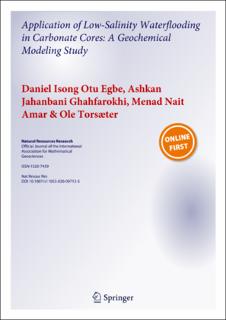| dc.contributor.author | Jahanbani Ghahfarokhi, Ashkan | |
| dc.contributor.author | Egbe, Daniel Isong Otu | |
| dc.contributor.author | Nait Amar, Menad | |
| dc.contributor.author | Torsæter, Ole | |
| dc.date.accessioned | 2020-06-22T07:56:25Z | |
| dc.date.available | 2020-06-22T07:56:25Z | |
| dc.date.created | 2020-06-21T14:25:07Z | |
| dc.date.issued | 2020 | |
| dc.identifier.citation | Natural Resources Research. 2020, | en_US |
| dc.identifier.issn | 1520-7439 | |
| dc.identifier.uri | https://hdl.handle.net/11250/2658945 | |
| dc.description.abstract | Waterflooding is the most widely applied improved oil recovery technique. Recently, there has been growing interest in the chemistry and ionic composition of the injected water. Low-salinity waterflooding (LSWF) is a relatively recent enhanced oil recovery technique that has the ability to alter the crude oil/brine/rock interactions and improve oil recovery in both clastics and carbonates. In this paper, the increase in the recovery factor during LSWF was modeled based on the exchange of divalent cations (Ca2+ and Mg2+) between the aqueous phase and the carbonate rock surface. Numerical simulations were performed using laboratory coreflood data, and oil recovery and pressure drop from experimental works were successfully history matched. The ion exchange equivalent fractions, effluent ions concentrations, changes in mineral moles, and pH have also been examined. Besides, an investigation of multi-component ionic exchange as a mechanism responsible for wettability alteration during LSWF in heterogeneous low-permeability carbonate cores is presented. The results show that wettability alteration is responsible for the increase in oil recovery during LSWF, as reflected by the shift in the crossover points of the relative permeability curves. A sensitivity study done on many key parameters (e.g., timing of LSWF injection, injection rate and temperature) and the mechanistic modeling method revealed that they all have huge effects on the process. | en_US |
| dc.language.iso | eng | en_US |
| dc.publisher | Springer Nature | en_US |
| dc.rights | Navngivelse 4.0 Internasjonal | * |
| dc.rights.uri | http://creativecommons.org/licenses/by/4.0/deed.no | * |
| dc.title | Application of Low-Salinity Waterflooding in Carbonate Cores: A Geochemical Modeling Study | en_US |
| dc.type | Peer reviewed | en_US |
| dc.type | Journal article | en_US |
| dc.description.version | publishedVersion | en_US |
| dc.source.journal | Natural Resources Research | en_US |
| dc.identifier.doi | 10.1007/s11053-020-09712-5 | |
| dc.identifier.cristin | 1816486 | |
| dc.description.localcode | Open Access This article is licensed under a Creative Commons Attribution 4.0 International License, which permits use, sharing, adaptation, distribution and reproduction in any medium or format, as long as you give appropriate credit to the original author(s) and the source, provide a link to the Creative Commons licence, and indicate if changes were made. The images or other third party material in this article are included in the article's Creative Commons licence, unless indicated otherwise in a credit line to the material. If material is not included in the article's Creative Commons licence and your intended use is not permitted by statutory regulation or exceeds the permitted use, you will need to obtain permission directly from the copyright holder. To view a copy of this licence, visit http://creativecommons.org/licenses/by/4.0/. | en_US |
| cristin.ispublished | true | |
| cristin.fulltext | postprint | |
| cristin.qualitycode | 1 | |

